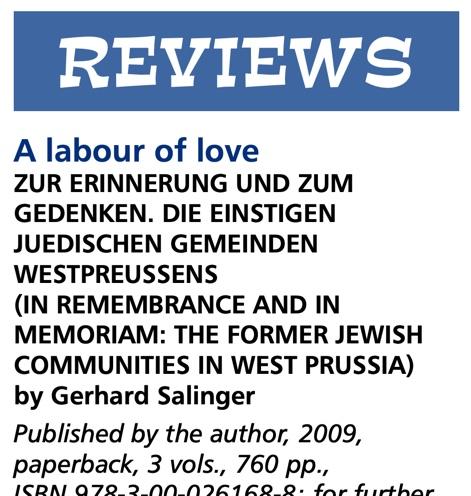Gerhard Salinger study of Jewish Stargard
A German-American Jewish historian, Gerhard Salinger, who is the author of detailed studies of the Jewish communities of Pomerania and West Prussia, has collected the available Jewish records for the town where our Wohlgemuth family originated.
We learn this from a December 2010 review of Salinger's West Prussia book by Dorothea Shefer-Vanson in the Journal of the Assoiation of Jewish Refugees, in which she describes Salinger's methods using his work in Stargard as an example. Here is the relevant passage from the review.
So how has he set about his seemingly overwhelming task? Take the town of Preussisch Stargard (now Starogard Gdanskie) as an example (see Part I). What can the reader expect to find here? Apart from a brief potted history, Salinger notes that two Jews, Mendel Salomon and Alex Baruch, were permitted to settle there in 1774 because they possessed more than 1,000 Taler. By 1812 there were 112 Jewish households, and individual names - both original and adopted later - are listed.
The population had grown to 597 by 1840, to 688 by 1849, and to its highest number (802, 13.7 per cent of the population) by 1870. There was a synagogue, a rabbi and a school.
Salinger goes on to list all those Jews who paid taxes in 1883, stating their names, occupations and places of residence. There is also a list of tax-payers in 1911. The names of two men who lost their lives in action during the First World War are given, as are extracts from the Secret State Archives in Berlin concerning the election of Jewish officials and other matters.
There is a list of deaths, giving names and age, going back to 1848, and a long list of deaths from 1857 until the community ceased to exist. It is striking that many died at a relatively young age. There is no information on where and how they died, but it is nonetheless an extraordinarily detailed survey.
On his visit to the town, Salinger discovered that the synagogue is now used as a shopping centre and that the greatly neglected cemetery has a number of gravestones, many severely damaged but five still standing upright, with the names of Mendelsohn and Wohlgemuth recognisable. Photographs of the former synagogue and the cemetery are provided.
How wonderful that he has called out the recognizable Wohlgemuth headstone that we have already discovered among the resources at Virtual Shtetl. More importantly are the multiple lists of residents, taxpayers, deaths, and war casualties for various years between 1812 and 1918. Undoubtedly we wiill be able to find more about our Wohlgemuth ancestors in Stargard by examining the actual book.
It is written in German in three volumes and evidently there are very few copies in existence. I will be trying to track it down.

